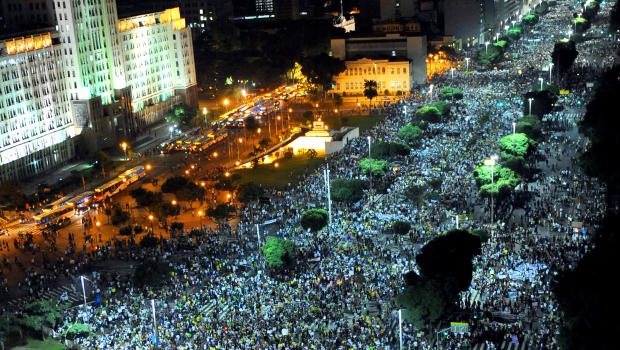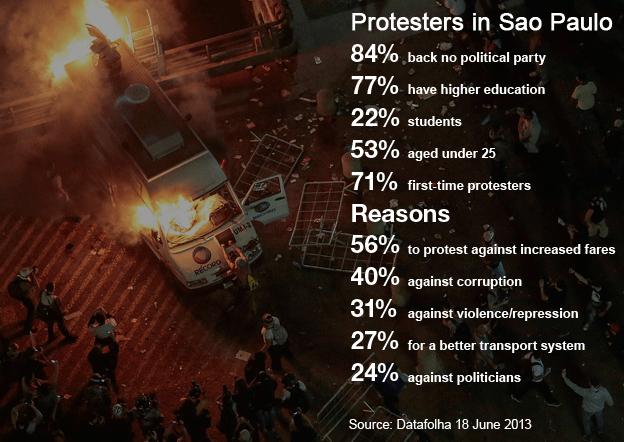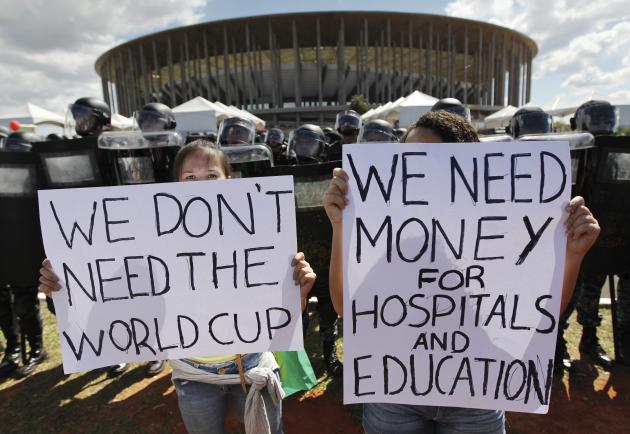Brazilian Protests About Far More Than Bus Fare Hikes

On June 17, over 200,000 protesters took to the streets in several of Brazil’s largest cities. Rio de Janeiro saw nearly 100,000 protesters, while São Paulo saw 65,000—and many more demonstrated in the streets of other major cities throughout the country. The protests are the largest and most widespread to occur in the country since 1992, when over 700,000 people rallied to demand the impeachment of then President Fernando Collor de Mello. [1] Since beginning this Monday, the protests have grown with more than one million people in over 100 Brazilian cities taking to the streets. [2] (For a breakdown of protest locations and numbers, click here).
This week’s large demonstrations stem from what initially began two weeks earlier as protests against a hike in bus fares in several major Brazilian cities. The crowd then swelled following a violent police reaction, as officers fired rubber bullets and discharged tear gas canisters at protesters. The shock of police brutality incited further protests throughout Brazil, which then exploded into the nation-wide movements that have been seen over the past several days.
Many city governments, including those of São Paulo, Porto Alegre, Cuiaba, and Recife, have responded by cutting back on recent bus fare increases. The response at this point seems to demonstrate a desire by Brazil’s government to address protesters’ concerns by attempting to alleviate the issue that sparked the initial protests. However, the reduction of bus fares fails to respond to the real motivations that have spurred hundreds of thousands to protest in the streets of Brazil’s cities. Bus fare hikes sparked the fire, but the long-existing societal issues are fueling the flame.
This week’s mass mobilizations stemmed from a growing discontent among the Brazilian people in regards to their government’s social spending priorities. Although the country has been lauded for its innovative, poverty-alleviating Conditional Cash Transfer (CCT) program founded under former President Luiz Inácio Lula da Silva, there is still much room for improvement when it comes to meeting the interests of the average Brazilian. Brazil’s protesters are now questioning their elected officials’ priorities and responsiveness to their needs due to rising discontent with deficiencies in infrastructure and transportation, and the status of education, healthcare, and security spending. In the context of the billions of reais allocated towards the upcoming world sporting events, including the Confederations Cup, World Cup, and the Olympic Games, these protests demonstrate a widespread expression of constituent power and poses a challenge to the state to address constituent concerns.
Historical Context
Brazil is well-known for its poverty reduction efforts, which have been praised internationally for its innovative CCT program, Bolsa Família. This program transfers funds to low-income families on the condition that they send their children to school and utilize the health services available to them. Despite efforts like Bolsa Família, there is still rampant inequality in Brazil, bringing a more complex perspective to statements made by President Dilma Rousseff, which claim that Brazil has lifted 40 million people up to the middle class in the past eight years as a result of its expanding economy and progressive poverty reduction programs. These programs are important, and many people’s livelihoods are contingent on these transfers, but they are clearly insufficient. At the end of 2012, Brazil had a reported GINI coefficient of approximately 51.9. [3] Though this is a vast improvement from a GINI coefficient of 61.0 in 1990, there is still much that needs to be done in order to combat the inequality that is a daily reality for millions of Brazilians.
Brazil has been lauded as a forerunner in Latin America with regards to economic progress and social initiatives. Yet this BRIC country fails to meet the basic needs of a huge percentage of its citizens, choosing instead to improve its international profile through impressive infrastructure in order to accommodate the World Cup and Olympics participants and attendees. However, the questionable priority of Brazil’s investments is only one of the many facets of the frustration that has Brazil in an uproar.

Reasons For Protest
Infrastructure and Transportation
Although the protests in Brazil cannot be explained solely by the bus fare hike, the hike is undeniably representative of larger infrastructural and transportation issues in large Brazilian cities. Citizens have become angered about money going into things like soccer stadiums when many cannot afford to travel to work or school, or even to receive adequate health care. In many of the largest Brazilian cities like São Paulo and Rio de Janeiro many people are forced to travel hours to get to and from work in the city centers.
Although the protests stem from frustrations well beyond a bus fare hike of 20 centavos ($0.09 USD), this change does place a considerable financial burden on millions of Brazilian people. This increase is not insignificant for those who must take three or four buses to get both to and from work, particularly in a country where the minimum wage is 678 reais/month ($312 USD; approximately $9.60 USD/day). [4] Even a small fare increase can make the difference in a person’s ability to pay for housing and food for their families. Furthermore, many people in Brazil who make up the informal labor market earn much less than this monthly minimum and would be even more adversely affected.
In Rio de Janeiro, the rise in bus fares is also associated with the recent banning of public transportation vans in the Zona Sul, the southern zone of the city. These vans are the primary mode of transportation for many of the city’s most impoverished citizens, as they are both cheaper and more efficient than buses. However, in response to rapes in vans in the city, the government banned the use of the vans in the popular tourist zone rather than actually addressing the root of the problem—violence toward and the mistreatment of women. The tendency to address problems at the surface rather than at their roots can also be seen in Brazilian infrastructural projects. For example, the Federal housing project Minha Casa Minha Vida (My House, My Life) provides low-income housing, but tends to house people far from the city centers where they work, forcing them to depend on unreliable and expensive public transportation.
These infrastructural and transportation issues have been particularly exacerbated by investment in upcoming world sporting events like the Confederation Cup, World Cup, and the Olympics. Brazil’s most impoverished communities have consistently and disproportionately borne the brunt of this spate of misguided spending in transportation and infrastructure.

Revitalization and the World Cup
When Brazil was chosen to host the 2014 FIFA World Cup and the Summer Olympic Games in 2016, Brazilians originally were excited by the visibility and prestige of hosting two of the world’s largest sporting events. They were promised increased investment in the development of Brazil, particularly regarding improvements in the country’s weak infrastructure and transportation systems. However, many Brazilians have been frustrated by the government’s investment priorities. Residents of Brazil’s many favelas have been particularly affected, as the construction projects and city “improvements” have disproportionately disrupted their neighborhoods, bringing evictions and demolitions to make way for these new projects. For example, in Morro da Providência, Rio de Janeiro’s first favela, the city has begun construction on a cable car that has required the eviction and demolition of hundreds of homes. Actions like these demonstrate the Brazilian government’s skewed priorities, as these people have few other housing options and see their needs neglected in favor of spending on preparations for the World Cup and the Olympic Games.
City governments also have made attempts to decrease Brazil’s consistently high rates of violence, deploying Police Pacification Units (UPPs) into several favelas. These specialized police units push out drug traffickers and gang members, and establish a permanent presence in order to “pacify” the favela. Although these efforts have proven successful in many of the neighborhoods in which they have been implemented, favela residents remain critical. UPP efforts up to now have primarily focused on favelas located near wealthy areas and places expecting high tourist traffic in the coming years. Residents have criticized these pacification efforts, indicating that much of the violence and drug trafficking is being pushed elsewhere, as opposed to being eliminated. National Public Radio recently reported on the increased rates of violence in a Rio suburb, Mage, where many residents see the increase as a result of crime being pushed out of the city by pacification units. [5] Though the implementation of UPPs demonstrates the Brazilian government’s commitment to decreasing violence and crime, it is ultimately another example of treating the symptom rather than the disease. They have merely reduced violence in those areas that will see an influx of tourists, pushing such crime outwards to other neighborhoods.
The failure to adequately address security issues and the skewed investment priorities in preparation for the World Cup and the Olympic Games demonstrate a key motivation for the recent protests throughout Brazil: the people’s perception that the government is unresponsive to their needs. The protests reflect the justifiable frustrations felt by hundreds of thousands of Brazilians when they see billions of dollars being spent on preparations for these two mega-events and relatively little investment in human development.
Concerns about preparations for 2014 and 2016 have been further exacerbated by many Brazilians’ frustrations in struggling to acquire adequate health care, education, and other social services. The recent fare hikes served as the last straw, pushing Brazilians to protest en masse. Many Brazilians used this opportunity to express their frustrations over the country’s lack of investment in human development, in addition to their concerns regarding infrastructure and transportation. Felipe Goncalves, a 33-year-old human resources worker involved in the protests, illustrates the last point clearly when he says, “The government pays for the World Cup but we don’t have hospitals. We don’t have schools, education.”[6]
Larger Implications for Democracy
The recent protests throughout Brazil clearly represent more than dissatisfaction with a hike in bus fares. More generally, these protests signify a fight to ensure that the government adequately represents its constituency’s needs. Protesters continue to emphasize that gaining international prestige for hosting upcoming sporting events should not be an absolute priority while the basic needs of so many are not being met. Paulo Sotero, Director of the Brazil Institute of the Woodrow Wilson International Center for Scholars and award winning journalist, stated, “Believe it or not, in the country of soccer, people are rallying against building and [the] renovation of soccer stadiums for the World Cup, saying that, well, maybe there are other priorities in this country.” He continued his remarks on the significance of these protests, saying, “…above all, this kind of rejection of a political system [… that] has become dysfunctional and no longer capable of producing the results that society wants.”
For the first time in more than twenty years, the world is seeing large-scale protests in Brazil. These demonstrations represent solidarity between the Brazilian people, who wish to adamantly defend their constitutionally-granted democratic rights. These protests address issues that stretch across class, race, and political affiliation. The people today are united under a common ideal of ensuring that democracy is upheld and that all Brazilian people, not just the wealthy elite, are having their voices heard. As Sotero stated, “Some members of political parties tried to raise their flags, and people were saying, ‘No, no, don’t do that. This not to divide; this is to unite.’” This demonstration of a unified Brazilian population conveys that the people will not allow their country’s fate to be determined by an elite few or the expectations of outsiders. Those who are going to be living in Brazil long after the crowds of fevered sports fans have left the Brazilian streets should be the priority.
A timely reevaluation of social services, though of course a long-term project, would be a worthy investment in Brazil, even at this time of high spending. Improvements in the quality of public education, health services, and affordable public transportation would be transformative for this still-developing nation. Admittedly, this is easier said than done. While these protests call into question whether or not hosting the upcoming series of world events is truly in the interest of the Brazilian people, the reality is that Brazil will indeed host both the World Cup and the Olympics in the coming years. Funds will inevitably need to be spent in order to prepare for these two high-profile events, but it is also necessary that the Brazilian government heed the demands of its people. In addition, the increased number of people present in Brazil’s cities who plan to attend the sporting events could create population pressures that Brazil is simply not ready for.
If Brazil hopes to guarantee the success of such events it needs to ensure that the needs of its people are being met. Failing to do so would risk inciting total chaos at a time when Brazil needs to show to the world that it is capable of being both a world leader and a successful model for sound development that is responsive to constituent concerns.
Sarah Otis, Stephanie Vancil, and Nicole Wasson, Research Associates at the Council on Hemispheric Affairs
Please accept this article as a free contribution from COHA, but if re-posting, please afford authorial and institutional attribution. Exclusive rights can be negotiated.
For additional news and analysis on Latin America, please go to: LatinNews.com and Rights Action
References
[1] “Collor’s Impeachment Demanded—More than 700,000 Join Protest Rally.” Associated Press, 19 Sept.1992. <http://community.seattletimes.nwsource.com/archive/?date=19920919&slug=1513871>
[2] “Brazil unrest: ‘Million’ join protests in 100 cities,” BBC. 21 June 2013. <http://www.bbc.co.uk/news/world-latin-america-22992410>
[3] Altman, Daniel. “A Real War on Inequality.” Foreign Policy, 17 Dec. 2012. <http://www.foreignpolicy.com/articles/2012/12/17/a_real_war_on_inequality>
[4] Bachega, Hugo.“Brazil lifts minimum wage, cuts tax on stock market earnings.” 23 Dec. 2012. <http://www.cnbc.com/id/100338302>
[5] Garcia-Navarro, Lourdes. “Criminals Fleeing Rio Crackdown Set Up Shop In The Suburbs.” NPR, June 7, 2013. <http://www.npr.org/blogs/parallels/2013/06/07/188688574/criminals-fleeing-rio-crackdown-set-up-shop-in-the-suburbs>
[6] Gupta, Girish. “Brazil’s Protests: Social Inequality and World Cup Spending Fuel Mass Unrest.” Time Magazine, 18 June 2013. <http://world.time.com/2013/06/18/brazils-protests-social-inequality-and-world-cup-spending-fuel-mass-unrest/#ixzz2Wg3pIdvB>

